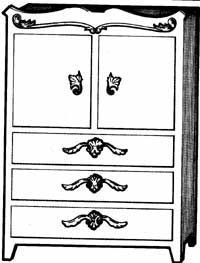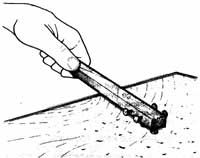Distressing Unfinished Furniture
Properly prepared and finished, unfinished furniture usually looks exactly like what it is: brand new. If you want a piece of furniture to look well worn, you can achieve the illusion of age with the technique of distressing.
Basically, distressing is adding the effects of years of wear and tear in just a few minutes. Old furniture usually has dents, dings, and worn edges; rungs may be flattened, chair seats smoothed down, or corners blunted. You can add the dents by pounding the wood, wear down the edges by rasping and sanding, and provide every appearance of long use.
Advertisement
The real trick of distressing is knowing when to stop -- what you want is a subtle effect of wear, not an obviously battered look. Distressing can be particularly effective under an antiqued finish.
General wear and tear is easy to imitate. Use the rounded end of a ball-peen hammer to make random dents in the surface. For overall battering, drive flatheaded tacks into a piece of 1x3, leaving the heads protruding slightly. Use this to pound the wood lightly and evenly. Large, shallow dents can be made with a large, smooth rock.
With any distressing tool, exercise a little restraint. If you hit the wood too hard, you'll end up with splits and splinters. Work in random strokes; don't mark the wood in any set pattern, such as rows. What you're aiming at is a general dulling or blunting of the brand-new look.
Over years of use, sharp edges gradually become rounded, and high-use spots -- chair arms or rungs, for instance -- show obvious wear. To produce this effect, round the edges of tops, drawer and cabinet fronts, and arms and legs with a medium-grit sandpaper on a block, and then sand the rounded surface smooth. On chairs, flatten the front rung slightly where you'd rest your feet against it. This rounding and flattening should be random and very gradual, with no obvious pattern; add noticeable wear only to the natural high-use spots. Absolutely even wear doesn't happen naturally, and it shouldn't be forced with distressing. Envision normal wear, and aim at this effect.

Very old furniture sometimes has worm holes, usually near a leg. Poorly faked worm holes are very obvious, but it isn't hard to make not-so-obvious fakes. To get the wormholed effect, make a few holes in strategic spots with the point of an ice pick. Drive the pick in to varying depths, so the holes are not all the same diameter and depth, and don't overdo it. A few holes can be convincing, but holes on the entire piece won't fool anybody.
When you've achieved the look -- or the degree of wear -- you want, go over the distressed wood lightly with fine-grit sandpaper. Smooth out any obvious rough edges or splinters, but be careful not to remove the marks of distressing. Then finish the piece.
Adding Decoration
Before you finish the piece of furniture, you can add decorative moldings or carvings to dress it up. This obviously isn't necessary if you like the design of the piece as it is, but if you want a more ornate look, decorations can be very effective. Decorative hardwood moldings and ready-to-finish carvings are available in many designs. Look for them at paint and hobby stores or order from a woodworking supply company. Attach wood decorations with brads or glue them into place; stain and finish them to match.
After you finish the piece, you can dress it up with new hardware -- brass hinges, china and brass drawer pulls, any type of hardware you like. Good hardware can be expensive, but it can do a lot for an otherwise undistinguished piece of furniture.
Speaking of hardware, what to you do with furniture hardware that's in need of repair. Find out on the next page.
